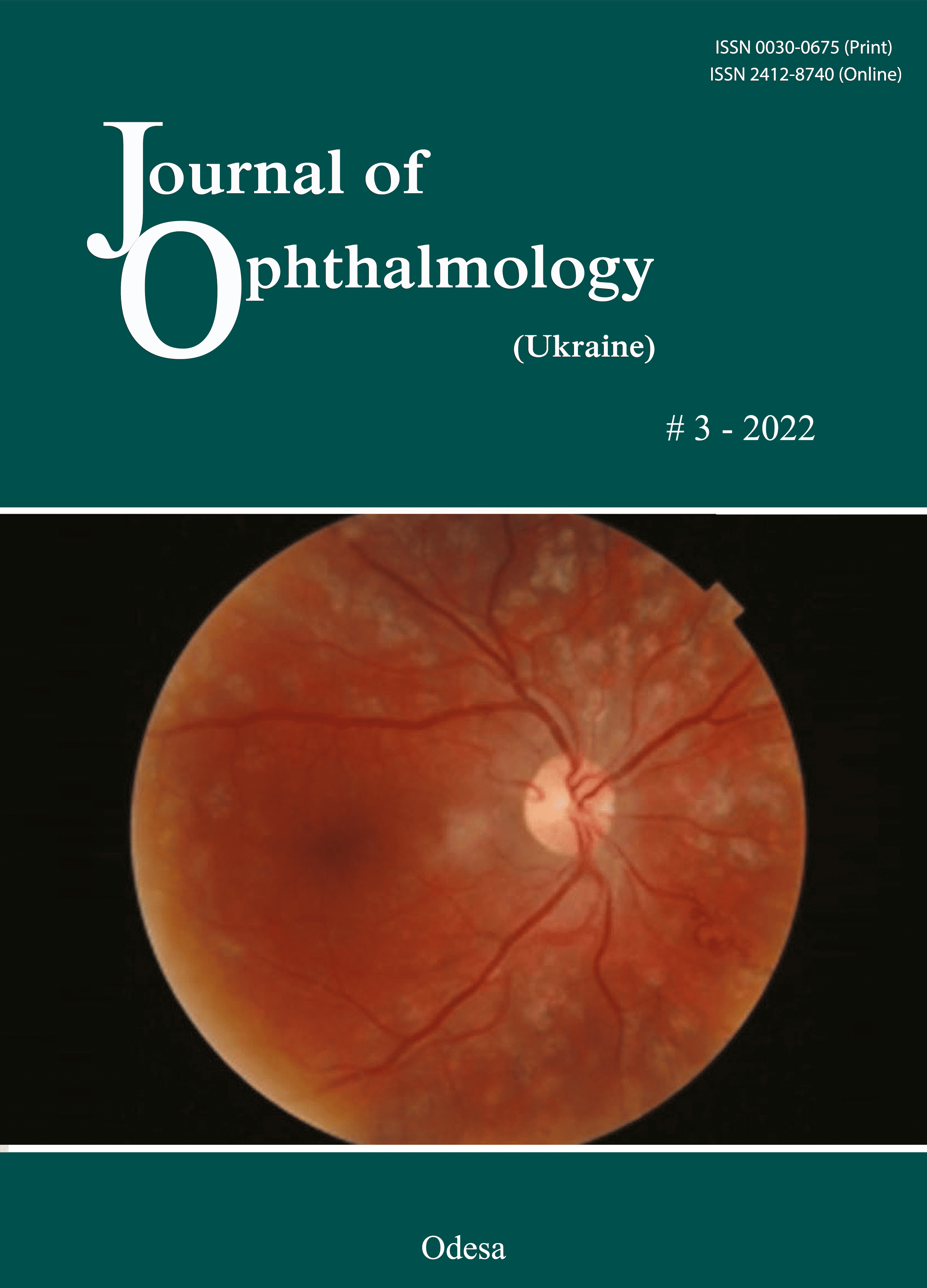Management of Accommodative Insufficiency among school-age children attending tertiary care Eye Institute
DOI:
https://doi.org/10.31288/oftalmolzh202221014Ключові слова:
accommodative dysfunction, flipper test, plus lens reading addition, vision therapyАнотація
Introduction. Accommodative insufficiency (AI) is a non-strabismic binocular vision anomaly characterized by an inability to focus for near vision, with symptoms of blurred near vision, headache, visual fatigue, and asthenopic symptoms.
Purpose. To evaluate the efficacy of Plus Lens treatment, and Flipper glasses in the improvement of Accommodative Amplitude (AA) and Near Point of Accommodation (NPA) in Accommodative insufficiency (AI).
Methods. A prospective study of 50 children aged 8-15years with distance heterophoria (< 2 pd), near heterophoria(< 6 pd), Near Point of Convergence (NPC) (10 cm/better on Royal Air Force (RAF) rule), and NPA (worse than 10 cm, 15d – 2.5* age) were recruited during July 2018 to June 2019 and followed up for 3months. Measurements including NPC, NPA, and AA were measured in each eye of the Plus Lens Reading Addition(PLRA) and Flipper group.
Results. Accommodative Insufficiency is higher in female children 67% in PLRA and 60% in the Flipper group with a mean age of 12.73 years in the PLRA group and 12.93 years in the Flipper group. NPA improved from 15.07 cm to 14.4 cm at 4 weeks, 11.87 cm at 8 weeks, and 9.33 cm at 12 weeks of treatment with PLRA. The NPA improved from 15.73 cm to 12.4 cm at 4 weeks, 10.93 cm at 8 weeks, and 8.27 cm at 12 weeks of treatment with Flipper glasses. AA improved from 6.73 D to 7.03 D at 4 weeks, 8.5 D at 8 weeks, and 10.73 D at 12 weeks of treatment with PLRA. The AA improved from 6.33 D to 8.03 D at 4 weeks, 9.13 D at 8 weeks, and 11.73 D at 12 weeks of treatment with Flipper glasses. Children reported good compliance and no longer experienced blur or headache.
Conclusion. A higher level of improvement in NPA and AA is observed in the Flipper group. Faster improvement is seen in the Flipper group, and treatment time needed will be shorter in the Flipper group, but it is more difficult to motivate subjects to do orthoptic exercises as compared to wearing reading glasses.
Посилання
1.Cooper J. Accommodative dysfunction. In Amos JF (Eds.), Diagnosis and management in vision care. Boston: Butterworths (1987): 431-459.
2.Scheiman M, Wick B. Clinical Management of Binocular Vision: Heterophoric, Accommodative and Eye Movement Disorders, 3rd ed. Philadelphia, PA: Lippincott, Williams and Wilkins; 2008.
3.Daum KM. Accommodative dysfunction. Doc Ophthalmol 1983; 55: 177-98. https://doi.org/10.1007/BF00140808
4.Hennessey D, Iosue RA, Rouse MW. Relation of symptoms to accommodative infacility of school-aged children. Am J Optom Physiol Opt 1984; 61: 177-83. https://doi.org/10.1097/00006324-198403000-00005
5.Nunes AF, Monteiro PM, Ferreira FB, Nunes AS. Convergence insufficiency and accommodative insufficiency in children. BMC ophthalmology. 2019; 19 (1):1-8. https://doi.org/10.1186/s12886-019-1061-x
6.García-Muñoz Á, Carbonell-Bonete S, Cacho-Martínez P. Symptomatology associated with accommodative and binocular vision anomalies. Journal of Optometry. 2014; 7 (4): 178-92. https://doi.org/10.1016/j.optom.2014.06.005
7.Wahlberg M, Abdi S, Brautaset R. Treatment of accommodative insufficiency with plus lens reading addition: is+ 1.00 D better than+ 2.00 D?. Strabismus. 2010 Jun 1;18(2):67-71. https://doi.org/10.3109/09273972.2010.485243
8.Hussaindeen JR, Murali A. Accommodative Insufficiency: Prevalence, Impact and Treatment Options. Clinical Optometry. 2020;12:135. https://doi.org/10.2147/OPTO.S224216
9.Shukla Y. Accommodative anomalies in children. Indian Journal of Ophthalmology. 2020 Aug;68(8):1520. https://doi.org/10.4103/ijo.IJO_1973_18
10.Scheiman M, Cotter S, Kulp MT, Mitchell GL, Cooper J, Gallaway M, Hopkins KB, Bartuccio M, Chung I. Treatment of accommodative dysfunction in children: results from an random clinical trial. Optom Vis Sci 2011;88(11):1343. https://doi.org/10.1097/OPX.0b013e31822f4d7c
11.Sterner B, Abrahamsson M, Sjostrom A. Accommodative facility training with a long term follow up in a sample of school aged children showing accommodative dysfunction. Doc Ophthalmol. 1999; 99: 93-101. https://doi.org/10.1023/A:1002623107251
12.Daum KM. Accommodative insufficiency. Am J Optom Physiol Oрt. 1983; 60: 352-9. https://doi.org/10.1097/00006324-198305000-00002
13.Hoffman L, Cohen AH, Feuer G. Effectiveness of non - strabismus optometric vision training in a private practice. Am J Optom Arch Am Acad Optom.1973; 50: 813-6. https://doi.org/10.1097/00006324-197310000-00008
14.Rune Brautaset, Marika Wahlberg, Saber Abdi, Tony Pansell. Accommodation Insufficiency in children: Are Exercises better than Reading Glasses? Strabismus. 2008; 16: 65-69. https://doi.org/10.1080/09273970802039763
15.Abdi S, Rydberg A. Asthenopia in schoolchildren, orthoptic and ophthalmological findings and treatment. Doc Ophthalmol. 2005; 111(2): 65-72. https://doi.org/10.1007/s10633-005-4722-4
16.Scheiman M, Cotter S, Kulp MT, et al. Treatment of accommodative dysfunction in children: results from a randomized clinical trial. Optom Vis Sci. 2011; 88(11): 1343-1352. https://doi.org/10.1097/OPX.0b013e31822f4d7c
##submission.downloads##
Опубліковано
Як цитувати
Номер
Розділ
Ліцензія
Авторське право (c) 2025 Dr. T. Suparna D. O., Dr. Swaroopa Gudimetla M. S.

Ця робота ліцензується відповідно до Creative Commons Attribution 4.0 International License.
Ця робота ліцензується відповідно до ліцензії Creative Commons Attribution 4.0 International (CC BY). Ця ліцензія дозволяє повторно використовувати, поширювати, переробляти, адаптувати та будувати на основі матеріалу на будь-якому носії або в будь-якому форматі за умови обов'язкового посилання на авторів робіт і первинну публікацію у цьому журналі. Ліцензія дозволяє комерційне використання.
ПОЛОЖЕННЯ ПРО АВТОРСЬКІ ПРАВА
Автори, які подають матеріали до цього журналу, погоджуються з наступними положеннями:
- Автори отримують право на авторство своєї роботи одразу після її публікації та назавжди зберігають це право за собою без жодних обмежень.
- Дата початку дії авторського права на статтю відповідає даті публікації випуску, до якого вона включена.
ПОЛІТИКА ДЕПОНУВАННЯ
- Редакція журналу заохочує розміщення авторами рукопису статті в мережі Інтернет (наприклад, у сховищах установ або на особистих веб-сайтах), оскільки це сприяє виникненню продуктивної наукової дискусії та позитивно позначається на оперативності і динаміці цитування.
- Автори мають право укладати самостійні додаткові угоди щодо неексклюзивного розповсюдження статті у тому вигляді, в якому вона була опублікована цим журналом за умови збереження посилання на первинну публікацію у цьому журналі.
- Дозволяється самоархівування постпринтів (версій рукописів, схвалених до друку в процесі рецензування) під час їх редакційного опрацювання або опублікованих видавцем PDF-версій.
- Самоархівування препринтів (версій рукописів до рецензування) не дозволяється.












